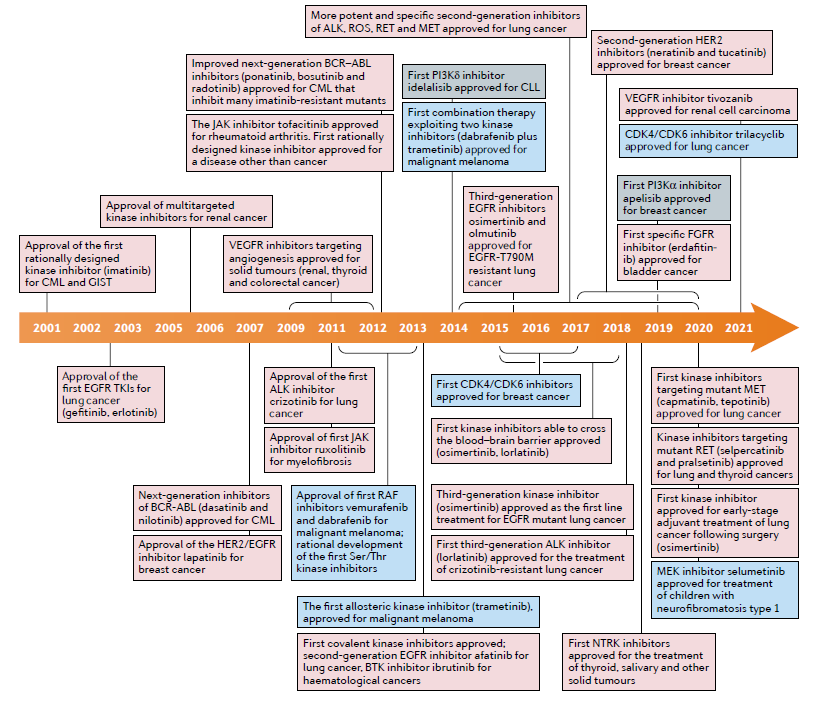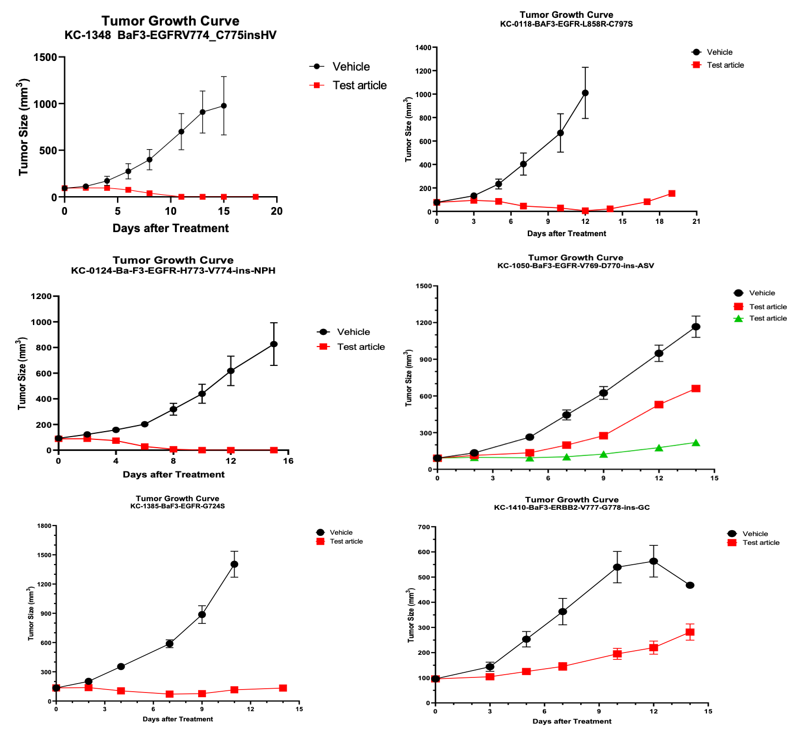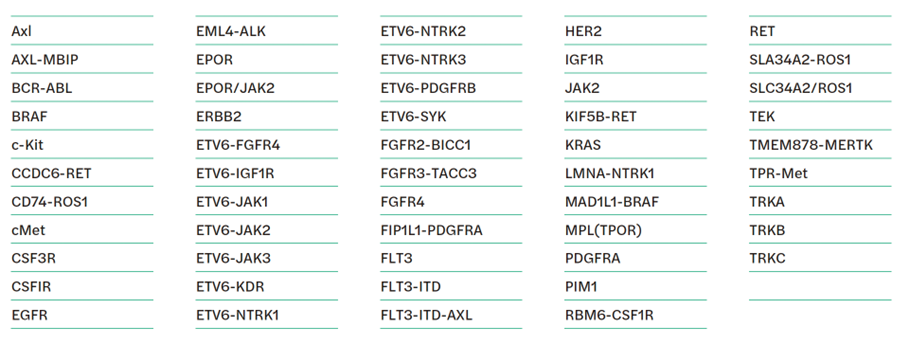Ba/F3 Kinase Cell Lines
Kyinno Ba/F3 Kinase Screening Cell Lines
Kinases regulate nearly all aspects of cellular activities, and alterations in their expression or gene mutations can lead to the development of cancer and other diseases. Twenty-one years ago, Imatinib, the first kinase inhibitor, was approved by the FDA, marking the beginning of a wave of drug development targeting kinases. Today, over 70 new drugs have been approved in this category [1]. However, this journey has been marked by a cycle of hope and disappointment. Drugs initially demonstrate clinical effectiveness, only for resistance to develop, leading to the resurgence of diseases. As a result, strategies have evolved, including combination therapies targeting different kinases, combining kinase inhibitors with traditional chemotherapy drugs, using antibody drugs targeting kinases, antibody-drug conjugates, irreversible kinase binders, allosteric kinase binders, and employing AI for drug design, among others, all focused on kinases.
While, thus far, only slightly over 50 out of 518 kinases have become drug targets, kinase inhibitors are expected to remain a primary growth area in drug development for the next 20 years [1]. The next generation of inhibitors will emphasize improved specificity, reduced resistance, and the ability to penetrate the blood-brain barrier. In the context of resistance, the combination of kinase inhibitors and other treatment modalities to collectively combat resistance will continue to be a focus.

Based on Ba/F3 cell lines, Kyinno has established a platform for kinase activity screening at both the cellular and animal levels. To date, over 500 Ba/F3 kinase-stable cell lines have been created, with more than 300 cell lines currently under construction. Kyinno has provided pharmacological and efficacy research services to over 200 users worldwide.
Ba/F3 Kinase Screening Cell Lines
Ba/F3 cells are mouse pre-B cells that rely on IL-3 for growth. They were first described by Palacios and Steinmetz in 1985, who aimed to isolate pro-B cells dependent on IL-3 for growth from the bone marrow of Balb/c mice. Subsequently, Daley and Baltimore demonstrated that the expression of the Bcr-Abl tyrosine kinase driven by a retrovirus could allow Ba/F3 cells to grow independently of IL-3, marking the beginning of the use of Ba/F3 cells as a tool in cancer research, especially in kinase studies.
The ability to make Ba/F3 cells express kinases with constitutive activity and monitor cell growth in the absence of IL-3 provides a convenient way to evaluate kinase transformation abilities [4]. Ba/F3 cells expressing kinases with mutations can be used to assess how these mutations alter kinase transformation abilities. Due to their rapid growth, with a doubling time of approximately 20 hours, Ba/F3 cells are suitable for high-throughput screening of small molecule kinase inhibitors. In this context, Ba/F3 cells offer a single kinase background with no interference from other kinases, ensuring high specificity. In addition, the infection of Ba/F3 cells with retroviruses carrying kinase genes with different mutations [5] or the induction of mutations in Ba/F3 cells expressing specific kinases using ENU [6] can be used for screening kinase inhibitor resistance mutations.
Utilizing Ba/F3 cells in kinase research and drug discovery is based on the following characteristics of these cells: 1) They grow rapidly in suspension; 2) They are easily transfected by electroporation or infected using common retroviral and lentiviral expression systems; 3) They can proliferate and survive independently after expressing kinases with constitutive activity or other oncoproteins, no longer relying on IL-3.
Applications of Ba/F3 Cells
- Assessment of kinase transformation abilities
Research of kinase downstream signaling pathways - High-throughput screening of small molecule kinase inhibitors at the cellular level
- Efficacy testing of kinase inhibitors in animal models
- Prediction of resistance to small molecule kinase inhibitors
- Screening for mutations that cause resistance to small molecule kinase inhibitors
Examples of Ba/F3 Cell Applications


2. Screening for mutations causing resistance to small molecule kinase inhibitors targeting ETV6-BTK.
Ba/F3 cells expressing ETV6-BTK are induced with mutations using ENU and then treated with the ETV6-BTK inhibitor Ibrutinib under conditions without IL-3. This results in the development of resistant cell lines, with sequencing revealing the presence of the F517L mutation.


3. In vivo assessment of kinase inhibitor anti-tumor activity.
Ba/F3 cells grow tumor-like structures well in mice. Transfection of Ba/F3 cells with kinases allows for testing the anti-tumor activity of kinase inhibitors in animal models.

Examples of Ba/F3 Cell Applications
Kyinno has already constructed more than 500 engineered Ba/F3 cell lines, with more than 300 new cell lines currently under development. The list includes most reported kinase targets and associated mutations.

- Philip Cohen, Darren Cross and Pasi A. Jänne, Kinase drug discovery 20 years after imatinib: progress and future directions. Nature Reviews Drug Discovery 2021; 20:551-569
- Palacios R, Steinmetz M. Il-3-dependent mouse clones that express B-220 surface antigen, contain Ig genes in germ-line configuration, and generate B lymphocytes in vivo. Cell 1985; 41:727-734
- Daley GQ, Baltimore D. Transformation of an interleukin-3 dependent hematopoietic cell line by the chronic myelogenous leukemia-specific p210bcr/abl protein. Proc Nat Acad Sci USA 1988; 85:9312-9316.
- Lacronique V, Boureux A, Valle VD, et al. A TEL-JAK2 fusion protein with constitutive kinase activity in human leukemia. Science1997; 278:1309-1312.
- Mohammad Azam, Robert R. Latek, and George Q. Daley. Mechanisms of Autoinhibition and STI-571/Imatinib Resistance Revealed by Mutagenesis of BCR-ABL. Cell 2003; 112:831-843.
- Takamasa Koga, Kenichi Suda and Tetsuya Mitsudomi. Utility of the Ba/F3 cell system for exploring on-target mechanisms of resistance to targeted therapies for lung cancer. Cancer Science 2022; 113:815-827